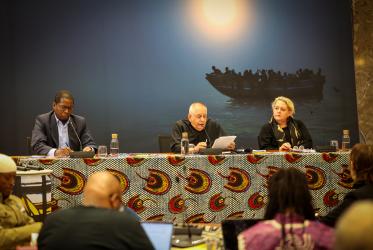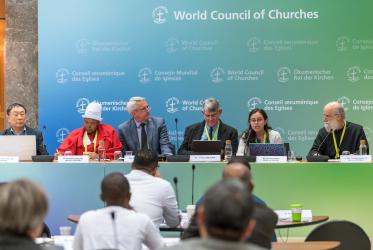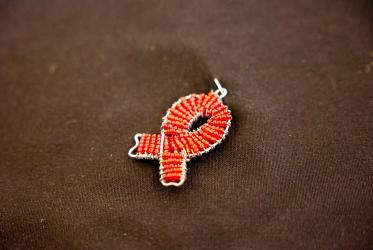PDF format
1. Preamble
Today, it is known that HIV infection is identifiable, preventable and manageable, and that with current medical know-how there is no reason why anyone should be dying of AIDS-related illnesses. The Christian community has done much across the globe to try and ease the pain and suffering of people caused by HIV and AIDS. out before reaching in.
This workplace policy is in keeping with the on-going work of the WCC and with the statement adopted by the WCC Central Committee on the basis of the WCC Consultative Group on AIDS Study Process, September 1996, which outlined a series actions which churches could undertake in responding to the HIV/AIDS pandemic in the "Conclusion: what the churches can do". It is informed by the ILO and UNAIDS workplace policies.
2. Objectives
The World Council of Churches' HIV/AIDS Workplace Policy is intended to:
- Minimise the possibility of HIV infection for categories of employees any of the aforementioned persons' spouses and dependents
- Assure a supportive work environment for employees living with or affected by HIV or AIDS
- Assure that employees and their spouses and dependents have access to care, support and treatment, including anti-retroviral therapy when necessary
- Manage and mitigate the impact of HIV/AIDS on the life and work of the Council.
- Mitigate the impact of denial, stigma and discrimination in the workplace whether on the basis of real or perceived HIV status, or vulnerability to HIV infection.
3. Responsibility for implementation
Responsibility for implementation of this workplace policy rests with the highest decision making authority of Council and will be implemented by the Human Resources office.
4. Confidentiality
4.1 The Council will encourage a supportive work environment in which employees can discuss HIV/AIDS openly, including their own experience living with HIV/AIDS. Where employees disclose that they or their spouse and/or dependents are living with HIV/AIDS, the confidence will be respected. Disclosure under all circumstances will be treated as shared confidentiality between the parties, unless expressly stated to the contrary. If there is any doubt, the person living with HIV/AIDS should be consulted before further disclosure takes place.
4.2 HIV-related information concerning prospective employees or current employees or any of the above mentioned people's spouses and/or dependents will be kept strictly confidential.
4.3 Employees shall sign a confidentiality agreement (Annex 2), and shall be informed that the unauthorised disclosure of HIV-related information is a disciplinary offence. It may also lead to legal proceedings against the person who disclosed the information.
5. Gender dimensions
5.1 Churches acknowledge that HIV/AIDS impacts on male and female employees differently in regard to physiological susceptibility to infection as well as reproductive health. It is also acknowledged that women normally undertake the major part of caring for those with AIDS-related illnesses, and that pregnant women with HIV have additional special needs.
5.2 Any assistance programmes will be designed to accommodate these differing impacts, and as appropriate to redress gender inequalities, for example by encouraging and supporting men as carers.
6. Safer practices (sexual or otherwise)
6.1 The HRO will provide employees with sensitive, accurate and up-to-date information to enable them to protect themselves from HIV and other sexually transmitted or blood borne infections as well as TB, Malaria and sleeping sickness.
6.2 Where staff travel to areas where the blood supply is deemed to be insecure, the HRO will provide information to employees as to where safe blood can be obtained or what action to take in case of illness.
6.3 Employees must wear helmets when on duty while travelling by motorcycle.
7. Occupational or other exposure
7.1 In the case of accidents involving the risk of exposure to human blood, universal precautions shall be used to ensure there is no risk of HIV transmission or other blood borne infections.
7.2 The HRO shall develop procedures for the immediate referral for counselling, assessment and medical treatment (with post-exposure prophylactics, where appropriate) of employees as well as their spouses and dependents exposed to the risk of HIV infection (e.g. through an accident or sexual assault), whether in the work place or elsewhere.
7.3 Reasonable paid time off will be provided for counselling following occupational or other exposure.
8. Voluntary counselling and testing
8.1. Access to free, voluntary and confidential HIV testing (VCT) and counselling shall be made available to employees as well as to their spouses through the health insurance scheme and /or where the service is not made available will provided will provide information as to where the services are available.
8.2. The General Secretary will nominate a person, ordained or lay, from whom employees can seek confidential advice, counselling and referral on HIV- or AIDS related matters.
9. HIV screening and employment
9.1 There is no obligation on prospective employees or current employees to inform the Council of their HIV status.
9.2 HIV status will in no way be taken into consideration for ordination, employment or placement within the Council.
9.3 HIV screening will not be required either as a condition of employment or for continuation of employment.
10. Information and training
10.1 The HRO will provide information and training on workplace issues raised by the HIV epidemic, on appropriate responses, and on the general needs of people living with HIV or AIDS and their carers.
10.2 Such information and training will be gender sensitive, as well as sensitive to race, disability, and human sexuality.
10.3 Information will include the availability of local support organisations for people living with HIV or AIDS, and other affected communities as well as people living with HIV or AIDS networks working in partnership with the Council.
10.4 Training for employees, if needed, on HIV/AIDS will take place during paid working hours and attendance by all employees will be considered as part of work obligations.
10.5 Such training will be open, where practicable, to the spouse and dependents of employees.
10.6 Relevant staff will be trained on the implementation of this policy.
11. Reasonable accommodation
11.1 Where appropriate the Council will assure reasonable accommodation to match the special needs of employees living with, or directly affected by, HIV or AIDS when and where practicable.
11.2 Reasonable accommodation may include flexible working hours and time off for counselling and medical appointments, extended sick leave, transfer to lighter duties, part-time work, and return-to-work arrangements.
12. Stigma and discrimination
12.1. The Council acknowledges that denial, stigma and discrimination related to HIV and AIDS is a sin and against the will of God. As such, the Council will not discriminate on the basis of actual or perceived HIV status under any circumstances, including opportunities for placement and advancement.
12.2. Employees living with HIV or AIDS will be treated no less favourably than employees with other serious illnesses will.
12.3. The HRO will undertake activities to address HIV- and AIDS-related stigma in the Council including through employee training and the promotion of an open, accepting and supportive work environment for all who chose to disclose their HIV status.
12.3. Employees who discriminate against people living with HIV or AIDS will be subjected to disciplinary procedures in the event that counselling efforts fail.
13. Advocacy for universal access
The failure to deliver ARV therapy to the millions of people who need it is a global health emergency. The Council will continue to be involved in advocacy work for access to treatments for all that need it?
14. Travel, assignment and vaccination
14.1 When arranging short-term travel to other countries for Council employees, the HRO will notify the individual of any legal restrictions on entry for people living with HIV. If an employee cannot undertake short-term travel for this reason or any other HIV health-related reason, reasonable accommodation will be made to identify other tasks.
14.2 When arranging long-term travel or reassignment for employees the HRO will notify the employee of any legal requirements for HIV screening. When HIV screening is required, the HRO will ensure referral to pre and post-test counselling for the employee, and will reimburse the cost for such counselling if it is not otherwise available free of charge.
15. Termination of employment
15.1 HIV infection is not a cause for termination of employment.
15.2 Employees with an HIV-related illness will continue in employment as long as they are medically fit for available, appropriate work.
15.3 In the case of termination of employment due to extended illness; employees with HIV or AIDS will be accorded the same benefits and conditions as apply to termination due to other serious illnesses.
16. Grievance and disciplinary procedures
16.1 The HRO will provide procedures that can be used by employees for work-related grievances, including failure to implement any aspect of this policy.
16.3 Disciplinary proceedings may be commenced against any employee who violates this policy.
Annex 1: Important definitions
Acquired Immunodeficiency Syndrome (AIDS) - is the late stage of the infection caused by the Human Immunodeficiency Virus (HIV). A person living with HIV can look and feel healthy for a long time before an AIDS diagnosis. However, HIV weakens the body's defence (immune) system until it can no longer fight off diseases and infections such as pneumonia, diarrhoea, tumours, cancers and other illnesses.
Human Immunodeficiency Virus (HIV) - this is the virus that may result in AIDS or Acquired Immunodeficiency Syndrome. HIV attacks the body's immune system - the system that fights against infections.
Anti-Retroviral (ARV) Therapy - drugs used in the treatment of HIV infection. They work against HIV infection itself by slowing down the reproduction of HIV in the body but are not a cure.
Employee is a person whose calling has been recognized and receives financial or other compensation for ministry exercised on a church's behalf, or lay people holding paid positions within churches.
Spouse is the married partner of the employee
Dependent is defined as a person:
- Living in the country but not necessarily in the same residence as the employee and for whom the employee is responsible.
In addition: - No distinction is to be drawn between adult and child dependants in terms of the coverage provided under the terms and conditions of this policy, and
- Up to a total of eight dependants, who must be registered by name with the church or faith-based organization, may be covered by the terms and conditions of this policy.
HIV-related information includes information that someone:
- may be living with HIV or AIDS;
- has been asked to have an HIV test or been counselled about having a HIV test;
- is receiving or has received treatment or counselling which suggests he or she may be living with HIV or AIDS;
- may have had experiences which puts him or her at risk of contracting HIV; or
- has a close association or relationship with someone living with HIV or AIDS.
HIV screening means any measurement of potential or actual HIV infection, whether direct (HIV testing), indirect (assessment of risk-taking behaviour) or asking questions about tests already taken or about medication.
Reasonable accommodation means any modification or adjustment to their work or responsibilities that is reasonably practicable and will enable a person living with HIV or AIDS to have access to, or participate or advance in employment.
Annex 2
Regional Epidemiological Data
HIV and AIDS epidemic in sub-Saharan Africa
Sub-Saharan Africa has just over 10% of the world's population, but is home to close to two-thirds of all people living with HIV some 25 million (range: 23.1-27.9 million). In 2003 alone, an estimated 3 million people (range: 2.6-3.7 million) in the region became newly infected, while 2.2 million (range: 2.0-2.5 million) died of AIDS. Among young people 15-24 years of age, 6.9% of women (range: 6.3-8.3%) and 2.1% of men (range: 1.9-2.5%) were living with HIV by the end of 2003.
Many African countries are experiencing generalized epidemics. This means that HIV is spreading throughout the general population, rather than being confined to populations at higher risk, such as sex workers and their clients, men who have sex with men, and injecting drug users. In sub-Saharan Africa, as the total adult population is growing, the number of people living with HIV is increasing, with the result
In sub-Saharan Africa, adult HIV prevalence appears to have stabilized. However, a stable prevalence is only possible if AIDS-associated deaths are replaced by new infections. Thus, in sub-Saharan Africa, a stable prevalence still represents more than 2 million new infections each year.
HIV and AIDS epidemic in Asia
Asia is now home to some of the fastest-growing AIDS epidemics in the world. In Asia, an estimated 7.4 million people (range: 5.0-10.5 million) are living with HIV. Around half a million are believed to have died of AIDS in 2003, and about twice as many1.1 million became newly infected.
Asia is faced with a narrow window of opportunity to prevent AIDS from having a more severe impact on the region. With 60% of the world's population, Asia is now home to some of the fastest-growing AIDS epidemics in the world. This is primarily due to sharp increases in HIV infections in China, Indonesia and Viet Nam, which together make up close to 50% of Asia's population.
The region includes the world's most populous countriesChina and Indiawith 2.25 billion people between them. In both countries, national HIV prevalence is low: 0.1% in China and between 0.4% and 1.3% in India. But a closer focus reveals that both have extremely serious epidemics in a number of provinces, territories and states.
In China, 10 million people may be infected with HIV by 2010 unless effective action is urgently taken. The virus has spread to all 31 provinces, autonomous regions and municipalities.
HIV and AIDS epidemic in Latin America and the Caribbean
In Latin America and the Caribbean, the total number of people living with HIV continues to rise. It is estimated that 2 million people (range: 1.6-2.6 million) are living with HIV in these countriesa figure that includes the 250 000 who were newly infected in 2003. In the same year, AIDS claimed approximately 120 000 lives.
In the Caribbean, 52 000 people acquired HIV in the past year, bringing the total number of people living with HIV to around 430 000 (range: 270 000-760 000). AIDS killed a further 35 000 people last year.
The Caribbean's epidemic is predominantly heterosexual, and is concentrated among sex workers in many places. However, the virus is spreading in the general population. Three countries in the Caribbean have national HIV prevalence levels of at least 3% - the Bahamas, Haiti, and Trinidad and Tobago and in addition Haiti is the worst affected country, with a national HIV prevalence of 5.6%.
Latin America's epidemic tends to be highly concentrated among populations at particular risk, rather than being generalized. In most South American countries, the majority of infections are caused by contaminated drug-injecting equipment or sex between men.
HIV and AIDS epidemic in Eastern Europe and Central Asia
In Eastern Europe and Central Asia, diverse epidemics are under way, and they show no signs of abating. In 2003, some 360,000 people were newly infected with HIV, bringing the number of people living with the virus to 1.3 million (range: 860 000-1.9 million). In the past year, AIDS claimed an estimated 49 000 lives.
In Eastern Europe, Estonia, Latvia, the Russian Federation and Ukraine are the worst affected countries in this region. However, HIV continues to spread in Belarus, Kazakhstan and Moldova.
Injecting drug use is the driving force behind this region's epidemican activity that has spread explosively in the turbulent years since the Soviet regime's demise. In the Russian Federation alone, there are estimated 3 million injecting drug users. The Ukraine has more than 600 000 and Kazakhstan has up to 200 000. In Latvia and Estonia, an estimated 1-% of the adult population injects drugs. Most of these drug users are male.
HIV and AIDS epidemic in Oceania
In Oceania, the total number of people living with HIV continues to rise. It is estimated that 32 000 (range: 21 000-46 000) people are living with HIV in these countriesa figure that includes the 4800 who were newly infected in 2003. AIDS claimed approximately 700 lives in the past year.
In Australia, following a long-term decline, the annual number of new HIV diagnoses has gradually increased from an estimated 650 cases in 1998 to around 800 in 2002. Papua New Guinea shares an island with one of Indonesia's worst affected provinces, Irian Jaya. It has the highest HIV prevalence in the Oceania region, with more than 1% among pregnant women in the capital, Port Moresby, and in Goroka and Lae. Papua New Guinea's epidemic appears largely heterosexually driven.
In other islands in Oceania, HIV infection levels are still low, but levels of sexually transmitted infections are high. High levels of sexually transmitted infections indicate behavioural patterns that could also facilitate HIV transmission beyond sex workers and their clients.
HIV and AIDS epidemic in the Middle East and North Africa
In the Middle East and North Africa, the latest estimates indicate 75 000 people acquired HIV in the past year, bringing the number of people living with HIV to 480 000 (range: 200 000-1.4 million). In 2003, AIDS killed a further 24 000 people. There is the potential for a considerable rise in HIV in this region.
Sudan is the region's most seriously affected country with an HIV prevalence of 2.3% The epidemic is most severe in the southern part of the country, where HIV prevalence among pregnant women is reported to be six-to-eight times higher than around Khartoum in the north. In the Sudan, heterosexual intercourse is the principal transmission route.
With the exception of a few countries, the region's systematic surveillance is not well developed. Furthermore, there is inadequate monitoring of higher-risk populations, including injecting drug users and men who sex with men. This means that potential epidemics in these populations are being overlooked.
HIV and AIDS epidemic in High-income countries
In high-income countries, the number of HIV-positive people continues to rise, largely due to widespread access to antiretroviral treatment. It is estimated that 1.6 million people (range: 1.1-2.2 million) are living with HIVa figure that includes the 64 000 who were newly infected in 2003.
In high-income countries, annual AIDS deaths have continued to slow because of the availability of antiretroviral treatment. This means HIV-positive people are staying healthy and surviving longer than infected people elsewhere. For example, in the United States, there were 16 371 reported AIDS deaths in 2002, down from 19 005 in 1998. In Western Europe, reported AIDS deaths fell from 3373 in 2001 to 3101 in 2002.
Annex 3
Confidentiality Agreement
(To be completed by all employees)
1. I have read and understand this Workplace Policy.
2. I recognise that through association with the WCC, I may learn information of a highly personal and confidential nature.
3. I understand that such information may include information that someone:
- may be living with have HIV or AIDS;
- has been asked to have an HIV test or been counselled about having a HIV test;
- is receiving or has received treatment or counselling which suggests he or she may be living with have HIV or AIDS;
- may have had experiences which put him or her at risk of contracting HIV; or
- has a close association or relationship with someone with living with HIV or AIDS.
4. I will only disclose such information when authorised by the person in question.
5. I understand that breach of this agreement may result in disciplinary action, and possible legal proceedings against myself and/or my church.
Signature.
Date and Place.
Witness.
Date and Place





